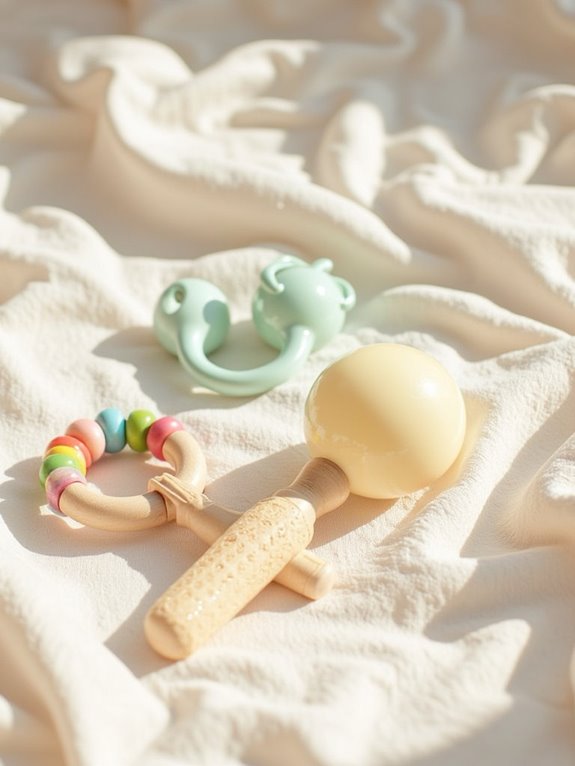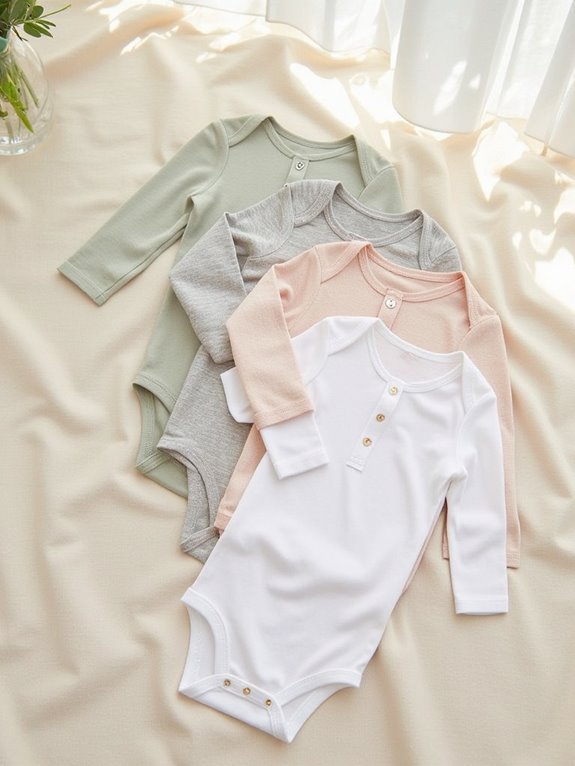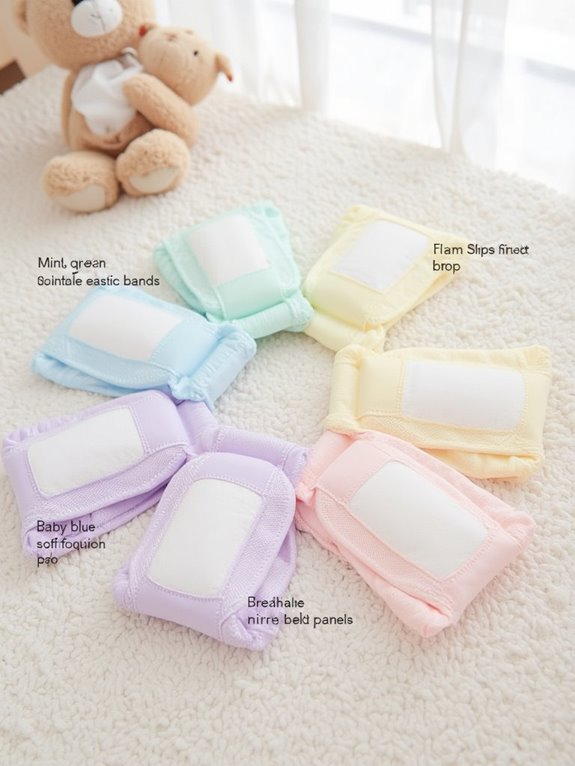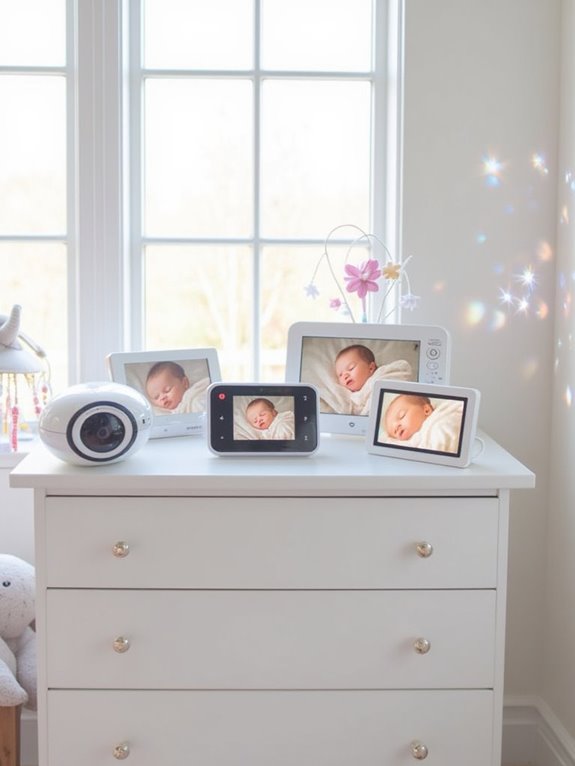Links below are affiliate links. We earn a commission on purchases at no extra cost to you. Although our opinions are based on curated research, we haven't used these products. Articles generated with AI.

3 Best Baby Rattles of 2025, According to Pediatricians
The top pediatrician-recommended baby rattles for 2025 include the Baby Lovey Montessori Wood Rattle Set, featuring natural materials and a soothing cotton teether; the iPlay, iLearn 10-piece set with BPA-free plastic toys that support diverse developmental needs; and the Montessori Sensory 4-in-1 set, offering food-grade silicone teethers and stacking rings. Each option prioritizes safety with non-toxic materials and meets rigorous testing standards. Below, you’ll discover essential factors that make these rattles stand out from competitors.
Key Takeaways
- The Baby Lovey Montessori Set ranks first with its natural wooden rattle and muslin cotton design, endorsed for safe teething and sensory development.
- iPlay, iLearn’s 10-piece set places second, featuring BPA-free toys that support multiple developmental stages with high pediatrician ratings.
- The Montessori Sensory 4-in-1 set ranks third, combining food-grade silicone and BPA-free materials for comprehensive infant development.
- All three top choices prioritize safety certifications, non-toxic materials, and age-appropriate designs recommended by child development experts.
- Each recommended rattle includes features for multiple developmental benefits, including sensory stimulation, motor skills, and teething relief.
Baby Lovey Montessori Wood Rattle & Teether Ring Set (3 Pack)
Sale
Baby Lovey, Wood Rattle, Teether Ring, 3 Pack Montessori Gift, Ginger, 100% Cotton, Double Gauze,...
- Made from natural wood, this wooden rattle and tooth ring has a smooth texture and smooth edges that won't scratch your baby's delicate skin
- This security blanket made of 100 muslin cotton that's naturally non irritating and perfect for drooling, teething baby
- The wooden rattle makes a sound when baby shakes it, which can attract baby's attention and help them stay happy
Parents seeking natural, safety-focused baby rattles will find the Baby Lovey Montessori Wood Rattle & Teether Ring Set an ideal choice for their little one’s developmental needs. This 3-pack set combines a smooth wooden rattle that won’t scratch delicate skin with a 100% muslin cotton teething blanket.
You’ll appreciate the set’s dual functionality: the rattle produces engaging sounds to stimulate your baby’s senses, while the breathable cotton blanket offers comfort during teething. The neutral colors and double gauze fabric create a calming aesthetic. It’s an excellent baby shower gift, arriving in presentable box packaging. The natural materials ensure safe teething and drooling absorption.
Best For: Parents seeking natural, eco-friendly teething and sensory development toys for babies aged 0-12 months who prioritize non-toxic materials and Montessori-style learning.
Pros:
- Made from natural materials (wood and 100% muslin cotton) that are safe for teething and drooling
- Multi-functional design combining rattle sounds for engagement with comfort blanket for soothing
- Thoughtfully packaged as a gift set with neutral colors suitable for any gender
Cons:
- May be more expensive than plastic alternatives due to natural materials
- Wood requires more careful cleaning and maintenance than synthetic materials
- Cotton comfort blanket may need frequent washing due to drool absorption
iPlay, iLearn Baby Rattles and Teether Toys Set (10 Pieces)
Sale
iPlay, iLearn 10pcs Baby Rattles Toys Set, Infant Grab Shake Rattle, Easy Hold Sensory Teether,...
- 10 Bright Primary colored Rattles/Teethers for different stages of baby’s development.
- Each rattle has different grips, shapes and tasks to assist in fine motor skills.
- Variety of textures will assist in tactile development of touch, taste and smell. Numerous sounds will expand babies’ sensory experiences, colors and patterns help eye...
The iPlay, iLearn Baby Rattles and Teether Toys Set stands out for families seeking extensive early development tools that’ll grow with their child from infancy through age 6.
This 10-piece set features BPA-free plastic toys with diverse shapes, textures, and sounds. You’ll find options like tambourines, music notes, and octopus designs that support:
- Fine motor skill development through varied grips
- Sensory exploration via multiple textures
- Visual tracking with bright colors
- Auditory stimulation from distinct rattling sounds
- Teething relief
With nearly 30,000 reviews and a 4.8-star rating, parents consistently praise the set’s durability and developmental benefits. Each piece measures 6 x 3.5 x 2 inches, making them ideal for small hands.
Best For: Parents seeking a comprehensive developmental toy set that can engage infants and toddlers through multiple growth stages while providing essential sensory and motor skill stimulation.
Pros:
- Exceptional variety with 10 different toys featuring diverse shapes, textures, and sounds for comprehensive developmental support
- High-quality, BPA-free materials that are both durable and safe for extended teething and play
- Outstanding value supported by nearly 30,000 positive reviews and a 4.8-star rating
Cons:
- Some pieces may be too heavy or challenging for very young infants to handle independently
- Storage solution not included, which may lead to pieces being scattered or lost
- Price point might be higher compared to simpler rattle sets with fewer pieces
Baby Montessori Sensory Toys for Infants 0-12 Months
ELLECK Baby Montessori Sensory Toys for 0-6 6-12 Months, Teething Toys for Babies 0 3 6 9 12 18...
- 👶🏻MONTESSORI SENSORY TOYS SET- Our 6 month old baby and infant toys come in a convenient set, with different colored blocks, soft stacking rings and baby sensory...
- 🦷SAFE MATERIALS&SOFT TEETHING MATERIAL - Made with food-grade silicone and high quality ABS. They are 100% BPA free and non-toxic. Lab tested and approved.
- 🍼EARLY LEARNING TOYS- Our baby toys 6 to 12 months are great for learning colors, shapes, textures, counting, and learning developmental concepts such as balance, fine...
Modern families seeking safe, educational toys will find exceptional value in these Montessori-inspired sensory toys designed specifically for infants aged 0-12 months. The 4-in-1 set includes soft stacking rings, teethers, rattles, and colorful blocks, all made from food-grade silicone and BPA-free ABS plastic.
Key features:
- Lab-tested materials safe for teething
- Supports motor skills and cognitive development
- Easy-to-clean, durable construction
- 4.5/5 stars from 419 reviews
Important safety note: Supervise play and avoid washing with soap to prevent water retention. While designed for sensory exploration, some small parts require close monitoring. Package dimensions: 8.11″ × 6.26″ × 6.14″, weight: 1.74 lbs.
Best For: Parents and caregivers seeking safe, educational toys for infants 0-12 months that support developmental milestones through sensory exploration and interactive play.
Pros:
- High-quality, non-toxic materials (food-grade silicone and BPA-free plastic) ideal for teething babies
- Versatile 4-in-1 design promotes multiple developmental skills including motor, cognitive, and sensory
- Strong customer satisfaction with 4.5/5 stars from over 400 reviews
Cons:
- Water can get trapped inside toys with holes, requiring careful cleaning and drying
- Some small parts may pose potential choking hazards requiring constant supervision
- Cannot be washed with soap, which may limit thorough cleaning options
Factors to Consider When Choosing Baby Rattles

When selecting a baby rattle, you’ll need to carefully evaluate five key factors that directly impact your child’s safety and development. You’ll want to check that the rattle meets current safety standards, is made from non-toxic materials, and features an age-appropriate design that matches your baby’s developmental stage. The rattle’s size, weight, sensory features, and ease of cleaning will also determine how well it serves as both a safe and engaging toy for your little one.
Safety and Material Quality
Selecting safe, high-quality materials stands as the most crucial factor when choosing your baby’s first rattle. You’ll want to verify the rattle meets current safety standards and features non-toxic, BPA-free construction to protect your infant from harmful chemicals.
Key Safety Features to Check:
- Rounded edges and no detachable parts that could pose choking risks
- Natural materials like organic wood or food-grade silicone
- Smooth surfaces free from splinters or sharp points
- Certified compliance with infant toy safety regulations
When examining potential rattles, carefully inspect the product’s material composition and safety certifications. Focus on brands that prioritize natural, allergen-free materials and maintain rigorous quality control. If you’re unsure about a rattle’s safety features, don’t hesitate to contact the manufacturer for detailed specifications or consult your pediatrician.
Age-Appropriate Design Features
Beyond material safety, age-appropriate design features play a key role in your baby’s developmental journey. When selecting a rattle, you’ll need to match the design with your infant’s age and abilities.
For Newborns to 6 Months:
- Choose lightweight rattles with large, smooth surfaces
- Look for high-contrast colors and simple designs
- Select rounded components that prevent choking risks
For Babies 6+ Months:
- Opt for rattles with varied textures and multiple grip points
- Consider models with integrated teething elements
- Choose designs that encourage more complex manipulation
Your baby’s motor skills and exploration needs will evolve rapidly during the first year. By selecting rattles with age-appropriate features, you’ll support their developmental progress while maintaining safety. Remember that secure attachments and rounded edges are essential across all age groups.
Size and Weight Considerations
Two critical factors – size and weight – directly impact your baby’s ability to safely enjoy and benefit from a rattle.
When selecting a rattle, you’ll want to focus on models that are lightweight enough for your little one to grasp and manipulate without strain. The ideal rattle should:
- Have a diameter of 2-3 inches for secure handling
- Feature balanced weight distribution to prevent tipping
- Be sized appropriately for your baby’s developmental stage
Weight distribution is particularly important – a well-balanced rattle stays firmly in your baby’s grip during play sessions. Avoid rattles that are too heavy or bulky, as these can strain your infant’s developing wrist muscles and make manipulation difficult. Your baby should be able to hold and shake the rattle comfortably without fatigue, allowing them to fully engage in this important developmental activity.
Sensory Development Elements
When choosing a rattle that supports your baby’s sensory development, you’ll need to contemplate how it engages multiple senses simultaneously. Look for products that combine different textures, colors, and sounds to maximize developmental benefits.
Key sensory features to consider:
- Auditory Stimulation
- Distinct sound patterns that help your baby distinguish between frequencies
- Clear, gentle rattling noises that support early language recognition
- Visual Elements
- High-contrast patterns and bright colors to enhance tracking abilities
- Multiple visual focal points for eye movement development
- Tactile Components
- Varied surface textures for sensory exploration
- Graspable sections with different touch sensations
- Optional vibrating elements for enhanced sensory processing
Select rattles that incorporate at least three different sensory elements to support your baby’s neural development and sensory integration skills.
Durability and Maintenance Needs
Since your baby’s rattle will face constant drops, throws, and vigorous shaking, durability and easy maintenance must be top priorities in your selection process. Look for rattles made from BPA-free plastic, natural wood, or silicone materials that can withstand repeated impacts while remaining safe for your child.
Maintenance Requirements:
- Plastic/Silicone Rattles: Clean with warm water and mild soap
- Wooden Rattles: Wipe down regularly, occasional polishing
- Complex Designs: May require careful disassembly for thorough cleaning
Safety Inspection Tips:
- Check regularly for cracks or loose components
- Ensure all edges remain smooth and rounded
- Replace rattles showing signs of wear
When shopping, select designs with simple shapes and minimal parts to make cleaning easier. Avoid rattles with intricate details that could trap dirt or become difficult to sanitize properly.
Educational Growth Potential
Beyond durability and maintenance, educational value stands out as a powerful factor in rattle selection. You’ll want to choose rattles that support multiple developmental stages and engage various senses simultaneously.
Look for these key educational features:
- Multi-textured surfaces that enhance tactile exploration
- Varied sound patterns that develop auditory discrimination
- High-contrast colors and patterns for visual development
- Ergonomic shapes that encourage grasping and manipulation
- Versatile designs that adapt to different developmental stages
When selecting a rattle, consider how it can grow with your child. The best options incorporate elements that stimulate both fine motor skills and cognitive development. Choose rattles with different shapes and materials to help your baby learn about object properties while strengthening hand-eye coordination. These features create a foundation for early learning and physical development.
Frequently Asked Questions
At What Age Should Babies Stop Using Rattles?
While rattles provide crucial sensory development for young infants, you’ll want to phase them out around 12-18 months. At this age, your baby’s fine motor skills and cognitive development require more challenging toys. You should remove rattles earlier if your child shows signs of using them as teething tools or if they’re starting to take them apart. Watch for loose parts that could become choking hazards during this changeover period.
How Often Should Baby Rattles Be Cleaned and Sanitized?
You should clean and sanitize your baby’s rattles daily, or more frequently if they’ve fallen on the floor or become visibly dirty. Here’s a simple cleaning routine:
- Wash with warm, soapy water after each use
- Sanitize weekly using a diluted bleach solution (1 tablespoon bleach per gallon of water)
- Let air dry completely before giving back to your baby
- Replace rattles that show signs of damage or deterioration
Can Babies Sleep With Rattles in Their Cribs?
According to the American Academy of Pediatrics, nearly 3,500 infant sleep-related deaths occur annually in the US. You shouldn’t place rattles or any toys in your baby’s crib during sleep time. They pose serious suffocation and strangulation risks. Even if your baby enjoys playing with rattles while awake, it is crucial to remove all objects, including rattles, from the crib before naps and bedtime. Keep the sleep space clear with just a fitted sheet.
What Materials Are Considered Unsafe for Baby Rattles?
You should avoid these unsafe materials in baby rattles:
- Small parts that could detach and pose a choking hazard
- Lead-based paint or toxic finishes
- Brittle plastic that can crack or splinter
- PVC containing phthalates
- Materials with sharp edges or points
- Batteries that aren’t properly secured
- Strings or cords longer than 7 inches
- Unfinished wood that can splinter
- Metal components that can rust or corrode
Always check for recalls and verify rattles meet current safety standards.
How Do I Know if a Rattle’s Noise Level Is Too Loud?
Like a tiny thunderstorm in your baby’s hands, a rattle’s noise shouldn’t startle or overwhelm. You can test a rattle’s safety by holding it about a foot from your ear – if it’s uncomfortably loud at this distance, it’s too loud for your baby. As a general rule, the sound shouldn’t exceed 85 decibels (about as loud as city traffic). You can also download a free decibel meter app on your phone to measure the exact sound level.







